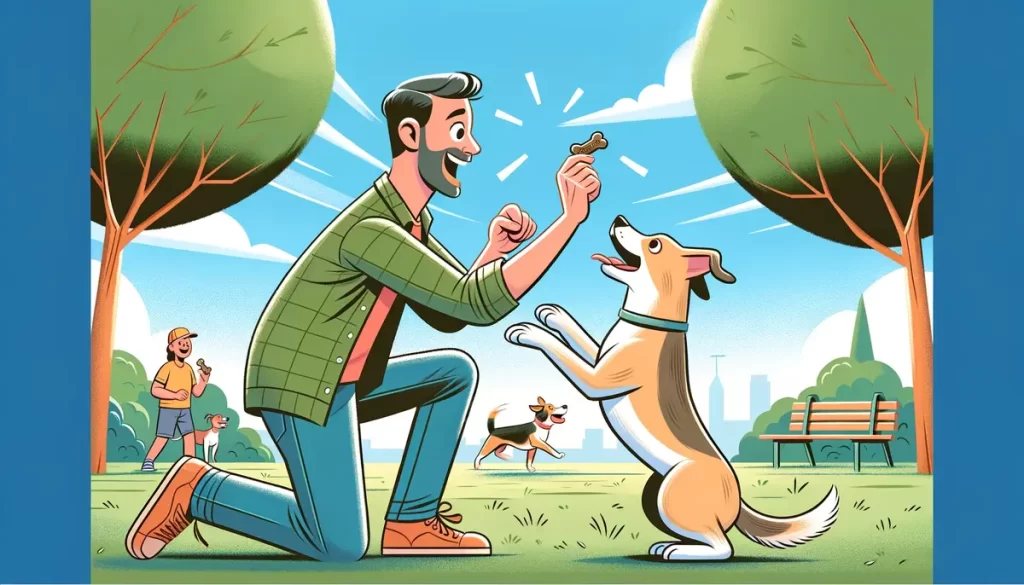Summary
The “come” or “recall” command is vital for your dog’s safety, ensuring they return to you when called, even with distractions. Start training indoors in short, fun sessions using positive reinforcement like treats and praise. Begin with your dog in a “stay” position and gradually increase the distance. Introduce distractions slowly. Use a consistent cue word like “come” or “here.” Fade treats over time, relying more on praise. Consistency and patience are key. A reliable recall can prevent accidents and strengthens your bond with your dog.
What Does the Term Come/Recall Mean?
Have you ever watched dog trainers throwing words like come re, call, or reliable call? A dedicated call means you want your dog to respond correctly and enthusiastically when you call them.
Just like humans, dogs are also conscious. You cannot expect dogs to listen to your orders like robots. But with the skill of recall/come, dogs will listen to you as much as possible.
Make your dogs come/recall training fun, lively, and enthusiastic
- Start training your dog in the house instead of going out for training. Your dog already knows your home so that the training will be less distracting. So the dog will be able to focus more on training.
- Give your dog rewards and treats when they come to you. Every dog loves treats. Your dog will listen to you more when you give him rewards and treats.
- When your dog finally starts responding to you when you call them, you can start with a verbal command like come, come here, go, etc.
- After some time, you can increase the distance between your dog. But treat them when they come to you on your command.
How to Teach a Dog to Come?
There are many ways to teach your dog to come when called. Just remember your dog will still need the skill to go in one or two days,
so you must be patient and enthusiastic with your dog. Remember not to scold or yell at your dog, and make this process fun for your dog.
Tips for teaching your dog how to come when called:
Start Training with Short Training Sessions
Start training your dog for short sessions at the start because dogs might get bored if the sessions are too long. Gradually increase session time.
Have Your Dog in the Stay Position
First, have your dog in a stay position to start the training. You can also get the help of another person who can hold your dog in a position of stay. Then, you take a few steps away from your dog when your dog’s hand is on the leash.
Cue Implementation
Clap your hand or do anything and ask your dog to come very politely. If your dog doesn’t listen to you, repeat it many times till your dog finally starts listening to you.
Give Your Dog Some High-Value Reward
When your dog has done the positive enforcement, please treat them with a high-value reward. You can give your dog hot dog bites, cooked chicken, or anything you like.
Start Practicing and Increase the Distance Gradually
Your dog is going to learn the skill in a period. So, keep practicing. Ulbrich, a professional dog trainer, said, “Levels of obedience are like grade levels,” you cannot expect your dog to start from 10th grade. Only practice will help your dog learn this skill.
When your dog listens to your command, you can increase the distance between them by keeping them at least six to seven feet away. Gradually, the distance will grow from six feet to ten feet and 10 feet to 20 feet.
Start Introducing Distractions in the Dog’s Way
Once your dog starts to listen to your command, start introducing distractions. Keep your dog at a distance of some feet from yourself and put some of your dog’s toys in the path to distract your dog.
Now call them to come, are they following your instructions like before or not. Suppose the dog is not following your instructions because of distraction at first; there is nothing to worry about. Just keep practicing, and the dog will eventually learn.
Throw Distractions in Another Way
Throw the dog’s toys in the other direction and then call them to come and see what they are doing. Do not be angry with your dog, even if they go to the toys first, instead of listening to your command to come. Just keep practicing.
Start Using Cue Words like ‘Here’ and ‘Come’
Start commanding them with cue words instead of calling your dogs by name once they have responded to your command, even when the distractions are present.
A professional dog trainer has explained the reason for using cue words. He said that when you call them by their name, they respond to it but do not tell you what they have to do, so it’s not a good way of training your dog.
Stop Giving a Treat to Your Dog
First, decrease the number of treats you give your dog over time and eventually stop. Keep practicing until they respond to your command, even when no treats are waiting for your dog when they come to you.
These are tips you can do to teach your dog the skill of come/recall. Remember, it will take time for your dog to learn this skill. So, take time to train your dog right. Be positive and consistent with practice.
Why is Your Dog Not Responding to Your Command ‘Come’?
Some dogs don’t respond to your commands at all. There can be a few reasons why the dog is behaving like this.
Not Given Enough Treats or Rewards from the Start
Dogs only practice with you daily if you give them enough rewards and treats.
They don’t feel happy and motivated to do the practice at all. So, giving your dog rewards, treats, and a lot of praise is significant in keeping your dog motivated for the training.
So, ensure you keep your dog in sight of all their deserved rewards.
Your Dog Still Needs Practice
Teaching how to come takes time. Ensure you dedicate enough time for your dog to teach them how to respond to the ‘come’ command. When you tell your dog to ‘come,’ use it with a verbal cue (signal with hand); it will help your dog learn the command fast.
Why are Dogs Needed to Learn the Command ‘Come’?
For the Safety of Your Dog
The utmost reason to learn the command ‘come’ is to protect your dog from danger. Suppose some unexpected incident like the dog running into the street, or he is about to get attacked by a wild animal as a raccoon happens. In that case, you can protect your dog with your voice commands.
Will Behave Properly in Public
When your dog learns to respond to your commands, it will behave nicely in public. Also, when your dog behaves appropriately in public, other dogs and people will come around your dog. And hence, your dog will experience more interactions.
Will Strengthen the Bond between You and Your Dog
When you start training with your dog daily, you will begin to understand your dog and his needs better than before, ultimately making your bond more potent with the dog.
Trained Dogs Experience Less Stress
It has been studied that a trained dog behaves nicely, interacts well with others, experiences less stress, and forms a much stronger bond with you than before.
Giving proper training to your dog to learn the ‘come’ command is essential. And as an owner, it is your responsibility to know how to teach a dog to come.
The training will be successful only when you and your dog work together. So, teach your dog all the commands and build a stronger bond with them.
Now, it is evident that humans are happier, more excited, and more relaxed around fur babies.
When training your dog, you must keep your energy and excitement high. So, make sure to keep the learning fun and lively. And this writing about how to teach a dog to come will be your best friend while training.


